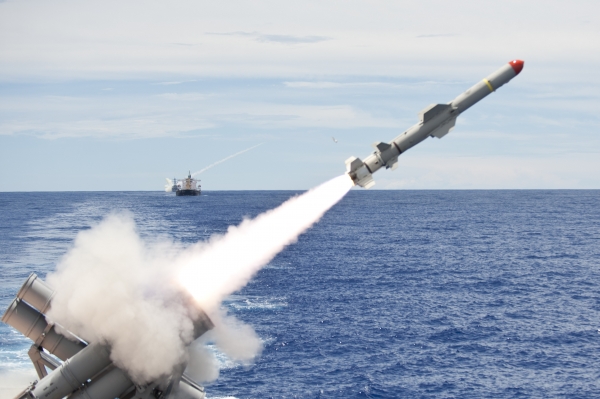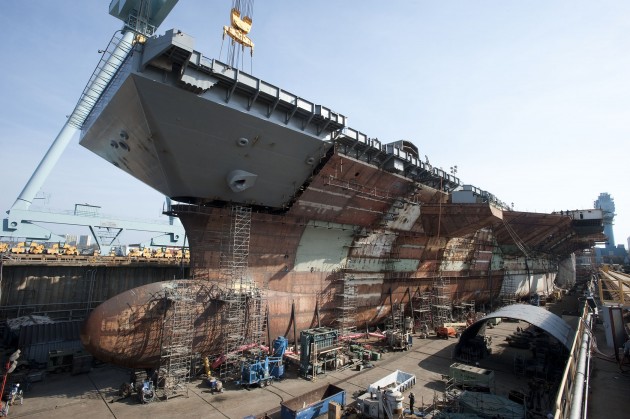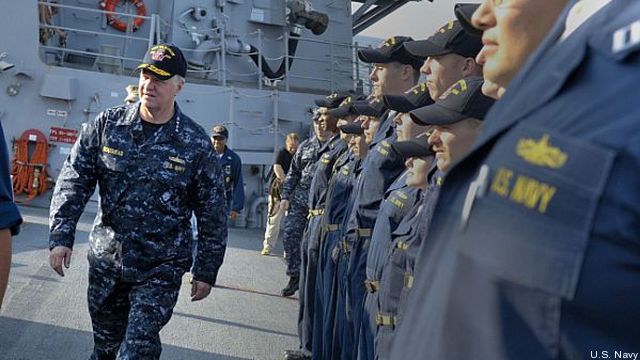
A Navy cruiser launches a Harpoon anti-ship missile, a 1977 design unsuited for long-range war in the Pacific.
2016 will be challenging for the Navy. At sea the fleet will continue to face demands that exceed its supply of forces, while at home the fiscal 2017 budget is likely to make difficult choices that prioritize high quality over adequate quantity. Most significantly for sailors, the supply-demand mismatch will get worse next year. While the fleet will grow by 10 ships in FY2016 (about 3.5 percent), implementation of a new process to better prepare carriers and surface ships for deployment will reduce the amount of presence the fleet can generate by about 10 percent.
This sustained stress will risk putting the Navy into a “death spiral” in which ships, aircraft, and sailors don’t get enough time at home to reset between deployments and then can’t deploy on schedule — as happened with the USS Eisenhower earlier this year. These delays further shrink the supply of ready forces and place more stress on those that remain. The cycle then repeats. The Optimized Fleet Response Plan (O-FRP), as the new preparation process is called, is a worthy initiative given the deteriorating material condition of some ships and the need for time to develop and practice new operational concepts. But putting O-FRP in place will require the Navy and DoD to reduce the number of ships deployed overseas. Look for the competition between presence and readiness to continue playing out in 2016.

The $13 billion supercarrier USS Ford under construction in Newport News, Va.
Growing the fleet
The Navy will increase quantity next year, but slowly. In particular, the supercarrier USS Gerald Ford will be commissioned and delivered, but that simply starts three years or more of outfitting and preparation for deployment. With recent Congressional direction to shock test the ship, the Ford may not go overseas until 2021. In the intervening time the fleet will remain at 10 carriers, which have been overworked to maintain presence in the Pacific while combatting the Islamic State in the Middle East. After a gap of more than two months without a carrier in U.S. Central Command, the USS Truman strike group reached the region last week.
Gaps in presence may be something the Navy and Defense Department need to live with to reset and build the fleet — but expect continued efforts by the Navy to get Congress to reconsider the shock testing decision.
To help address the presence shortfall, the Navy will field in 2016 several noncombatant and lower-end ships designed to stay overseas longer by using rotational civilian or military crews. The first new Expeditionary Mobile Base (ESB, formerly Afloat Forward Staging Base), USNS Lewis B. Puller, will deploy to the Persian Gulf to relieve the USS Ponce. The Navy’s two Expeditionary Transport Docks (ESD, formerly Mobile Landing Platform) will likely go overseas. Two more Expeditionary Fast Transports (EPF, formerly Joint High Speed Vessel) will join the fleet, as will five Littoral Combat Ships (LCS). Together, these rotationally-crewed ships will increase the Navy’s overseas presence by seven hulls, which would have required about 35 single-crewed combatants deploying from the continental United States.
The Littoral Combat Ship, however, will be plying some choppy waters in 2016. Defense Secretary Ash Carter’s Dec. 14 direction to truncate the program at 40 hulls and go to a single variant for the final eight “frigate-like” ships will potentially leave one of the ship’s two builders with no new ships after 2019 and the other builder with a substantially reduced workload. Although it reduces overseas presence in the 2020s by six ships, Carter’s decision is consistent with his emphasis on new high-end capabilities — part of a “Third Offset Strategy” — to deter competitors such as China and Russia. It also helps DoD address a $17 billion shortfall for FY 2017.
The Navy did itself no favors in the Littoral Combat Ship debate, however, with its choice to make the frigate upgrade only a slightly upgraded version of the LCS. Without the capability of a true frigate to conduct air defense of ships it escorts or to operate unaccompanied in high threat environments, the LCS “frigate” was not going to be able to contribute to the Offset Strategy or add significantly to the fleet’s firepower. Expect this debate to churn through 2016 when Congress takes up the FY2017 budget as members seek to protect their shipyards and the Navy looks for opportunities to further improve the frigate and make it more attractive to a future administration.
In the end, the truncation of the Littoral Combat Ship may be good for the Navy. It enables investment in key capabilities for the future, and the reduction in small combatant capacity could be made up in future ship construction budgets. For example, one potential outcome would be to base the single frigate variant on the Freedom-class LCS built by Marinette Shipbuilding in Wisconsin. This variant could be upgraded with a Vertical Launch System (VLS) magazine, the multi-purpose missile launcher standard on Aegis destroyers, an upgrade which would leverage Saudi Arabia’s investment in a modified Freedom-class LCS for their Eastern Fleet. Congress could then add more Expeditionary Fast Transports (aka JHSV) to the budget to be constructed by Austal in Alabama — which currently builds the Independence variant of LCS — to provide capacity for presence operations at relatively low cost.

LCS-1, the USS Freedom
Creating new ways of fighting
Using funds cut from the Littoral Combat Ship, Sec. Carter increased FY2017 investment in programs to counter anti-aircraft, anti-ship, and other anti-access weapons being fielded and sold by China and Russia. Congress has long argued the Navy needed to do more to counter advancing and proliferating threats, so legislators are likely to support the decision. The budget’s “plus-ups” for missiles, jammers, undersea warfare systems, and radars will particularly benefit Lockheed Martin and Raytheon, while the decision to buy more E-2D airborne early warning aircraft and F/A-18 E/F and F-35 strike fighters will help Northrop Grumman, Boeing, and Lockheed Martin respectively. These major industry players will also push to keep the FY2017 decision intact.
The recent assertiveness of Russia and China will likely continue into 2016, adding importance to these investments and placing additional pressure on the Navy for presence to deter aggression by both rivals. They will also help spur the continued development of new operating concepts for Electromagnetic Maneuver Warfare, Distributed Lethality, manned and unmanned undersea operations, and Navy Integrated Fire Control to improve the fleet’s ability to destroy enemy forces, deceive enemy sensors, and defend friendly and allied forces.
These new operating concepts will benefit from several new weapons being demonstrated in the fleet during 2016. Most prominently, USNS Trenton will deploy next year with a prototype electromagnetic railgun (EMRG) for at-sea testing in several different applications. For example, EMRGs could be an alternative to missiles for surface warfare out to 100 miles away or more, where the small size and high speed of its its projectiles makes them hard to shoot down. EMRGs may offer even more benefit in missile defense, in which the low cost and non-explosive nature of railgun projectiles means ships or shore magazines could carry many more weapons and significantly increase the capacity of air defenses.
The Navy’s previous highest profile weapon demonstration was the laser it deployed on USS Ponce in 2013. With the ESB Lewis B. Puller relieving Ponce next year, the Navy should keep advancing in this area by deploying a follow-on laser on another ship. Specifically, the Navy has been maturing solid state lasers through a program at the Office of Naval Research with the intent of reaching power levels able to damage some missiles and aircraft, as well as the unmanned vehicles and small boats that were vulnerable to the Ponce’s 30 kilowatt laser. Several other laser projects in DoD such as DARPA’s HELLADS have progressed since Ponce’s laser was fielded and could also be demonstrated at sea.
Lasers and other directed energy systems — such as high-powered microwave weapons to fry enemy electronics — are part of the Navy’s effort to change how its uses the electromagnetic (EM) spectrum. This Electromagnetic Maneuver Warfare (EMW) concept is largely complete and should be promulgated next year, joining complementary concepts from the Marine Corps and Army. Some new tactics associated with EMW are already being developed and demonstrated in the fleet.
The importance of Sec. Carter places on electromagnetic warfare explains his decision in the FY2017 budget to protect or increase procurement of SLQ-32 Surface Electronic Warfare Improvement Program (SEWIP) upgrades, the Next Generation Jammer, infrared search and track systems, and counter-electronic attack fighter radar upgrades. These systems incorporate technologies that will enable naval forces to implement new concepts for electromagnetic spectrum warfare, methods which will reduce the threat that adversaries can detect US forces while enhancing our ability to find the enemy with passive or low-probability-of-detection sensors.
The other services are moving in similar directions. They may be helped by the DoD Chief Information Officer (CIO), Terry Halvorsen, who recently suggested the department is beginning to consider the electromagnetic spectrum a domain akin to land or sea. Look for the new EW Executive Committee (EXCOM) to attempt to bring all these threads together in 2016 as it develops a strategy for how DoD will employ the EM spectrum.
New approaches for fighting in the electromagnetic spectrum, on the surface of the water, undersea, and in the air will rely on unmanned systems as weapons platforms, relays, sensors, decoys, and jammers. In 2016 the Navy’s newly created civilian Deputy Assistant Secretary of the Navy (DASN) for unmanned systems and its new uniformed director for unmanned systems (OPNAV N99) will work through their roles, priorities, and relationships as they tackle the FY2018 budget. Expect some growing pains as the Navy figures out how it will foster the development of new unmanned vehicle and deployable system technologies and transition them to platform sponsors in air, surface and undersea warfare.
The new organizations could help the Navy establish priorities for unmanned system development and focus investment to transition those that are most useful in emerging operating concepts. This would be a big change from the last decade, in which unmanned systems proliferated without a clear idea of how they would be used. Now that the technologies are more mature, the Navy should be advancing those they can use, instead of just buying what is available and then figuring out how to use them.

Sailors aboard the destroyer USS Sampson
Learning, adapting, innovating
Finally, the most significant new development for the Navy in 2016 may well be the new Chief of Naval Operations, Adm. John Richardson, and his focus on preparing the Navy and its sailors for an environment that is changing faster every day. Innovation has always been a hallmark of the Navy, but the advancing technology and geographic advantages of America’s competitors mean coming up with a new plan at the last minute won’t be enough.
New platforms and investments will only be effective if they are employed using relevant operational concepts and force packages. Further, new concepts will need to evolve more rapidly than in the past, so sailors will need to be better able to adapt to changing circumstances. Watch for new initiatives next year to establish a wider range of operational concepts, force packages, and equipment configurations to prepare the fleet for a more dynamic environment, as well as new training and preparation processes for sailors to enable them to better adapt.
Across the board, from operations to acquisition to experimentation and training, next year will be an interesting one for the Navy. It will have to reconcile the demands on the fleet with its supply of forces while building a capable force for the future in a tough fiscal environment. But it also has opportunities to configure and operate in new ways that will enable the Navy to be more flexible and adaptive. Changing course in rough seas is always dramatic, if not stomach-churning: As old sailors would say, stand by for heavy rolls.
Multi-ship amphib buy could net $900M in savings, say Navy, Marine Corps officials
Lawmakers gave the Navy authorities to ink a multi-ship amphib deal years ago, but the service has not utilized that power yet.


























